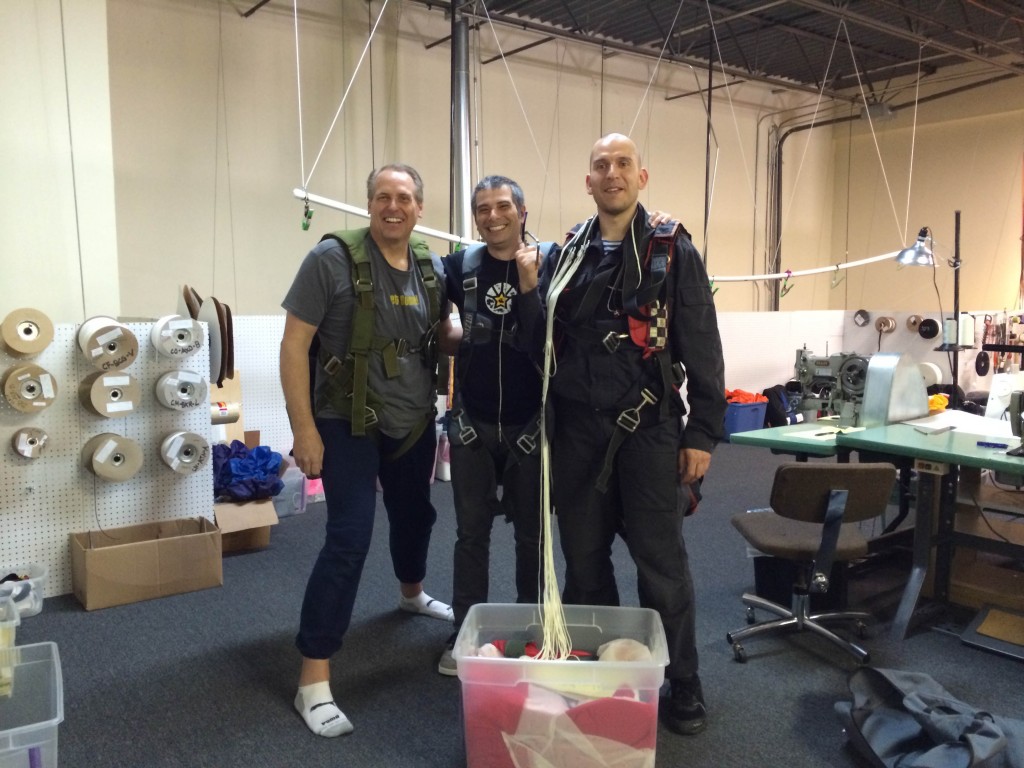So You Wanna Be A Parachute Rigger?
Packing parachutes while all of your friends are jumping out of airplanes all day or packing late into the night while they relax and party doesn't seem to make sense to most skydivers. But only riggers know the internal rewards of the mostly thankless profession of parachute rigging.
Be it the smile, hug, bottle or case after a save, or the pride in the beauty of a rig fully inspected/assembled/packed for the first time, or being able to patch a torn canopy so the jumper can get on the next load, rigging does have its rewards.
So where do you start? Just how do you get started on the unusual path of becoming an FAA Parachute Rigger?
Step 1: Learn The Basics
Some skydivers just start hanging out with the local rigger at their drop zone while they inspect, pack, assemble and repair rigs and parachutes. A rigger who will let you watch, and later assist, will be a godsend for you. If you do start on this path, get yourself a rigger logbook at this link so you can start logging any reserve pack jobs you complete under their supervision, as they all count toward the minimum requirements to become an FAA Senior Parachute Rigger.
Another option for learning the basics and/or expanding on what you initially learn with your local rigger, is attending a Rigging School, such as the one linked here by ChutingStar, which is held several times a year over the fall, winter and spring.
The minimum requirements needed before you begin the FAA paperwork and testing process for an FAA Senior Parachute Rigger is:
- 18 Years Old
- Read, Write, Speak and Understand English
- Packed and logged 20 Back Type Reserve Parachutes under the supervision of an FAA Senior or Master Rigger with a Back Type Rating.
Step 2: FAA Paperwork
Once you've met those minimum requirements, it's time to visit your local FSDO. A list of FSDO office can be found at this link. Or if you attend a rigging school course, usually an FAA Inspector from the local FSDO will be present at the end to start the paperwork.
The paperwork needed is two copies of the FAA 8610-2 form found at this link signed by you and an FAA inspector.
Step 3: Written Testing (New Procedures)
With your two signed 8610-2 forms, you are now eligible to take the FAA Parachute Rigger Written Test (RIG), which is actually a computer test of 50 questions. A complete list of testing centers can be found at this link. Those local to ChutingStar and/or attending one of our Parachute Rigger courses, will take the written test at the closest available testing center that day.
A new set of procedures for the Airmen Knowledge Test started on Jan. 13, 2020. In addition to needing your two FAA-inspector signed 8610-2 forms, you'll also need to:
- Obtain your FAA Tracking Number (FTN) by registering for an Integrated Airmen Certification and Rating Application (IACRA) at this link. You'll receive an FTN, which is required for scheduling your test.
- With your FTN, you can then schedule your Parachute Rigger (RIG) written/computer test at this link.
- Take your 2 copies of the 8610-2 forms, your ID and your FTN with you to the testing center, as they will need all of that for verification to allow you to take your scheduled test.
- After the test, you'll leave with an Airmen Knowledge Test Report and your 2 copies of the 8610-2 forms.
Before taking this test, make sure you study up on parachute terminology, rigging practices, FAA regulations and the like using several sources such as:
- Download and use the Dauntless GroundSchool FAA Written Test Preparation App at this link.
- FAA recognized texts, including the FAA Parachute Rigger Handbook, The Parachute Manual Vol. I & II, Parachute Rigger Study Guide and Parachute Rigging Course Manual. Each of these can be purchased at this link. (Note: The Parachute Manual Vol. I & II are no longer available new, so try to find one from another rigger.)
- FAA Parachute Rigger Handbook Change 1, available as .pdf only at this link.
- FAA Parachute Knowledge Test Guide FAA-G-8082-15F.
- Integrated Guide to Parachute Rigger Tests for The Modern Rigger Candidate by FAA Master Rigger Mark Baur is the latest study guide with the most up-to-date material, available at this link.
A passing grade on the RIG computer/written test is 70% and above. We have found that if you can score 90% or above on the practice online tests, you should score 70% or above on the actual test.
When you pass, you'll receive the Airmen Knowledge Test Report with your grade. You'll need that report plus the two original copies of the 8610-2 form to proceed to the next step. Do not let the testing center keep either of your 8610-2 forms, and, make sure you receive the Airmen Knowledge Test Report.
Step 4: Oral & Practical Test with a DPRE
The final step to earning your FAA Senior Parachute Rigger Certificate is passing the Oral & Practical Test given by a Designated Parachute Rigger Examiner, like this guy linked here.
It's no secret what can be part of the Oral & Practical Test, and you can read, prepare and practice for all the possible topics and projects listed in the FAA Parachute Rigger Practical Test Standards at this link.
Once you feel you are ready for the Oral & Practical Test, then contact your DPRE to sign up for the testing, such as this one linked here offered in Georgia.
You will need to show the DPRE your two 8610-2 forms and the Airmen Knowledge Test Report as well as your Rigger Logbook and current driver license. The DPRE will have some questions for you to make sure you're ready for the test. You then will schedule your test with the DPRE.
The Oral & Practical Senior Rigger Test averages 4-8 hours in length, but there is no required minimum or maximum time period for the test. It all depends on your current personal knowledge, confidence and speed with the ultimate requirement to bring the test projects to a "return to service" level.
Step 5: Certified FAA Senior Parachute Rigger
If/when you pass the Oral & Practical Test, you are issued your Temporary Airmen Certificate with your type rating and three letter/number seal symbol. Once you receive that signed copy of the FAA 8060-4 Form, you are now officially an FAA Parachute Rigger. Congratulations! You can perform all the privileges of an FAA Senior Parachute Rigger within the FAA Limitations and Regulations for your rating.
Within 120 days, you'll receive your 7-digit FAA Certificate Number on your permanent FAA Certificate to be used along with Seal Symbol. At this time you'll identify your reserve pack jobs with both identifiers (Certificate Number & Seal Symbol) on packing data cards.
Step 6: The Rigging Tool Kit
On the day you get your Seal Symbol from the DPRE, you can immediately order a Seal Press with your 3 letter/number identifier engraved, such as any of these linked here from ChutingStar.
By the time you're officially a rigger, you may already have started a tool kit to include basic hand tools you use for maintaining, packing and repairing skydiving gear. If you haven't, and/or you need more, you can put your personal tool kit together from the ChutingStar Rigging section at the links below.
- Rigger Hand Tools
- Rigger Supplies
- Rigger Tool Storage Bags & Kits
- Manuals and Logbooks
- Rigger Seal Presses, Seals and Safety Tie Thread
Step 7: Continuing Education
Earning your FAA Senior Rigger Certificate is essentially a license to learn. There is no way you can know everything it is you need to know to pack, maintain and repair all possible pieces of skydiving gear. Develop a list of other seasoned Senior and Master Riggers you can call on, and don't hesitate to contact a manufacturer with any specific gear questions or issues.
Continuing Education seminars and classes are offered at a minimum of every two years by the Parachute Industry Association, which has also started a Riggers Road Show. Continue to observe and help other riggers in your area to learn new tips and further develop your knowledge and skills. Contact manufacturers to see if you can shadow someone in their rigging department for a day or week. Watch and learn from other skydivers every weekend at the drop zone, who may not be riggers, but may have more knowledge on rigging just from being in the sport for a long period of time.
ChutingStar offers individual instruction on a per day basis for any rigger wanting to improve or learn new skills. You can sign up for that instruction at this link.
Any, some or all of that will help you become a trusted and respected rigger for a lifetime.
If you have any further questions, don't hesitate to contact ChutingStar's FAA Master Rigger and Atlanta-area DPRE Mike Gruwell at [email protected], or FAA Master Rigger Steve Haseman at [email protected].



